Hol Dir den wöchentlichen SPARTANAT-Newsletter.
Dein Bonus: das gratis E-Book von SPARTANAT.
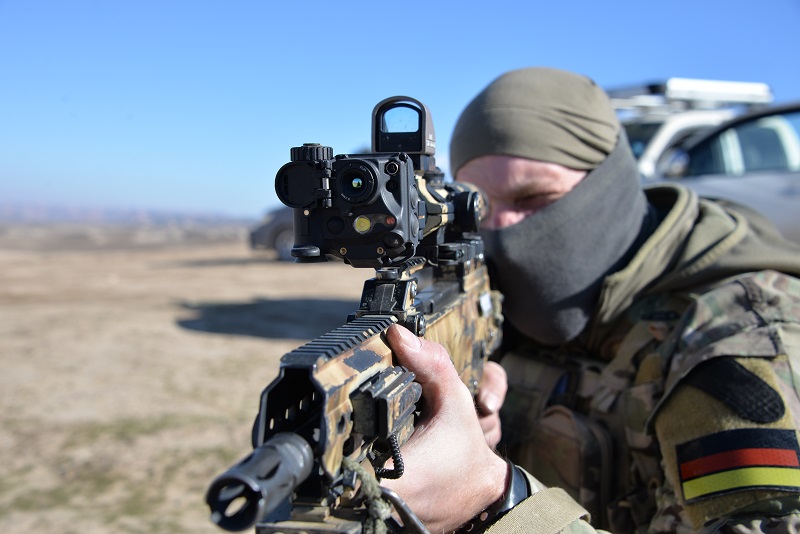
TILO-Challenge (3): Die TILO beim Militär
Die TILO-3Z+ von Andres Industries wurde in zwei unterschiedlichen Anwendungsgebieten getestet. Einmal in der zivilen, jagdlichen sowie in der militärischen Anwendung.
Die TILO-3Z+ von Andres Industries wurde in zwei unterschiedlichen Anwendungsgebieten getestet. Einmal in der zivilen, jagdlichen sowie in der militärischen Anwendung. Der jagdliche Test umfasste eine Zeitperiode von zwei Wochen und beinhaltete die Pirsch und den klassischen Ansitz. Der militärische Test umfasste eine Zeitperiode von ca. 12 Wochen und wurde unter realen Einsatzbedingungen in Afghanistan durchgeführt.
Vorweg ist zu sagen, dass während des gesamten Testzeitraumes keine technisches Problem mit der TILO-3Z+ auftraten. Auch die Gebrauchsspuren, bei nahezu täglicher Nutzung, an der TILO hielten sich in Grenzen, was die absolute Robustheit und höchste Qualität dieses kleinen Wärmebildgerätes wiederspiegelt.
Jagdlicher Test
Der jagdliche Test startete mit mehreren Nachtansitzjagden. Die Ansitzdauer betrug ca. 4 – 5 Stunden bei einer Außentemperatur zwischen 0° und 10° Grad Celsius. Die TILO-3Z+ wurde im Schwerpunkt im Thermalfilter RH = Red Hot verwendet. Dieser wurde in der Helligkeitsstufe 2-3 als sehr angenehm empfunden. Die durchschnittliche Laufzeit betrug zwischen 5 – 6 Stunden mit frischen Batterien. Das Gerät war aber nicht die gesamte Zeit in Betrieb, da gelegentliche Beobachtungspausen eingelegt wurden.
Die Beobachtungsentfernung lag zwischen 350m (Feldansitz) und 15m (Waldansitz). Auf „weite“ Entfernung (über 150m) stieß die TILO 3Z+ an die Grenzen der Identifizierbarkeit. Rehe, Wildschweine und Füchse konnten bis 100m klar unterschieden und identifiziert werden. Das reine Erkennen einer Wärmequelle bis 350m war problemlos möglich. Ein erlegtes Stück Wild, welches eine kurze Todesflucht von ca. 30 m in den Wald machte, konnte problemlos detektiert und aufgefunden werden.
Die Funktion des DIS Entfernungsschätzers wurde aktiviert und die Entfernungen konnten behelfsmäßig bis ca. 40m ermittelt werden. Die Messrahmen im Menü entsprachen in etwa der tatsächlichen Entfernung. Diese Funktion ist meines Erachtens für den jagdlichen Gebrauch nicht unbedingt notwendig, da der Messbereich zu gering ist. In der Regel kennt der Jäger sein Revier mit den jeweiligen Entfernungen im nahen Bereich.
Ansitz
Während einer Ansitzjagd im Wald wurde festgestellt, dass das Öffnen der Schutzklappe nach einer Beobachtungspause bei nahen Entfernungen (10m-35m) durch das Wild vernommen wurde. Mehrmals hintereinander konnte beobachtet werden, dass das Wild nach dem Anschalten in die jeweilige Beobachterrichtung sicherte und kurz darauf absprang. Des Weiteren flippte die Abdeckklappe nach dem Öffnen direkt an den hinteren Anschlagpunkt welches ebenfalls einen „lauten“ Ton verursachte. Daraufhin wurde die Funktion der Schutzkappe deaktiviert und das An- und Ausschalten über die Tastenkombination aktiviert. Dies ist grundsätzlich Möglich, aber mit Handschuhen nur schwer umsetzbar. Die Tasten sind für die Bedienung mit Hanschuhen zu klein.
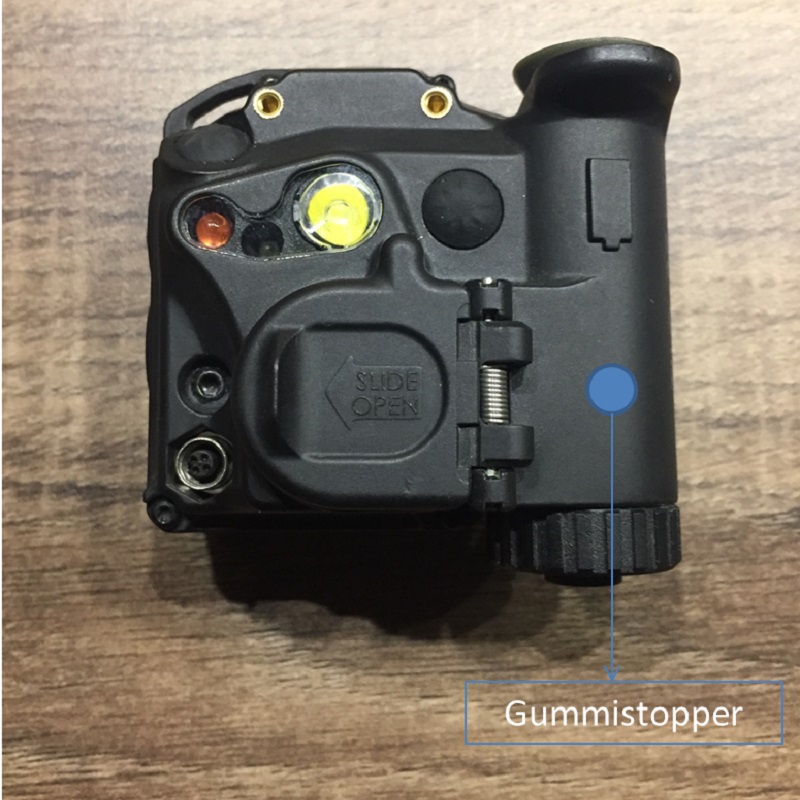 Grundsätzlich ist die Funktion der Schutzkappe sehr gut und zu bevorzugen. Die Geräuschentwicklung beim Anschlagen der Abdeckklappe am hinteren Anschlagpunkt kann durch ein Anbringen/Ankleben eines kleinen Schaumstoff- oder Gummi Stopper mittig am Batteriefach minimiert werden. Die Geräuschentwicklung beim Öffnen könnte durch eine zwei Stufen Verstell Rasterung beim Schließen, speziell für kurze Beobachtungspausen, minimiert werden.
Grundsätzlich ist die Funktion der Schutzkappe sehr gut und zu bevorzugen. Die Geräuschentwicklung beim Anschlagen der Abdeckklappe am hinteren Anschlagpunkt kann durch ein Anbringen/Ankleben eines kleinen Schaumstoff- oder Gummi Stopper mittig am Batteriefach minimiert werden. Die Geräuschentwicklung beim Öffnen könnte durch eine zwei Stufen Verstell Rasterung beim Schließen, speziell für kurze Beobachtungspausen, minimiert werden.
Pirsch
 Die Pirsch wurde mit dem GoPro Kopfband inkl. Adapter durchgeführt. Das Kopfband ist leicht und die TILO-3Z+ lässt sich gut vor das Auge positionieren. Auch hier wurde der RH= Red Hot Thermalfilter in der Helligkeitsstufe 2-3 verwendet. Ein schnelles Umgewöhnen der Augen an die Dunkelheit konnte somit gewährleistet werden. Leider veränderte sich die Position der TILO- 3Z+ während der Pirschbewegung minimal, was dazu führte keinen sauberen Einblick in das Okular zu haben. Das war sehr störend während der Pirsch. Das Gummikopfband verrutscht während der Bewegung, deshalb wandert die TILO-3Z+ zur Seite.
Die Pirsch wurde mit dem GoPro Kopfband inkl. Adapter durchgeführt. Das Kopfband ist leicht und die TILO-3Z+ lässt sich gut vor das Auge positionieren. Auch hier wurde der RH= Red Hot Thermalfilter in der Helligkeitsstufe 2-3 verwendet. Ein schnelles Umgewöhnen der Augen an die Dunkelheit konnte somit gewährleistet werden. Leider veränderte sich die Position der TILO- 3Z+ während der Pirschbewegung minimal, was dazu führte keinen sauberen Einblick in das Okular zu haben. Das war sehr störend während der Pirsch. Das Gummikopfband verrutscht während der Bewegung, deshalb wandert die TILO-3Z+ zur Seite.
 Ein Verbesserungsvorschlag meinerseits ist eine Kopfhaube in Verbindung mit einer NVG GoPro Mount. Verschiedene Hersteller bieten diese Kopfhaube an. Die Kopfhaube ist in Größe und Gewicht nicht mit dem Kopfband zu vergleichen, jedoch verändert sich die Position der TILO-3Z+ vor dem Auge in der Bewegung nicht und eine störungsfreie Pirsch wäre somit gewährleistet.
Ein Verbesserungsvorschlag meinerseits ist eine Kopfhaube in Verbindung mit einer NVG GoPro Mount. Verschiedene Hersteller bieten diese Kopfhaube an. Die Kopfhaube ist in Größe und Gewicht nicht mit dem Kopfband zu vergleichen, jedoch verändert sich die Position der TILO-3Z+ vor dem Auge in der Bewegung nicht und eine störungsfreie Pirsch wäre somit gewährleistet.
Fazit jagdlicher Test
Die TILO-3Z+ ist grundsätzlich für die Jagd ein überzeugendes Produkt. Besonders positiv aufgefallen ist die kleine Größe und das geringe Gewicht in Verbindung mit dem leistungsfähigen Wärmebildsensor. Gerade bei der Pirsch, vorausgesetzt die TILO bleibt sauber vor dem Auge positioniert, zeigt sie ihre Stärken.
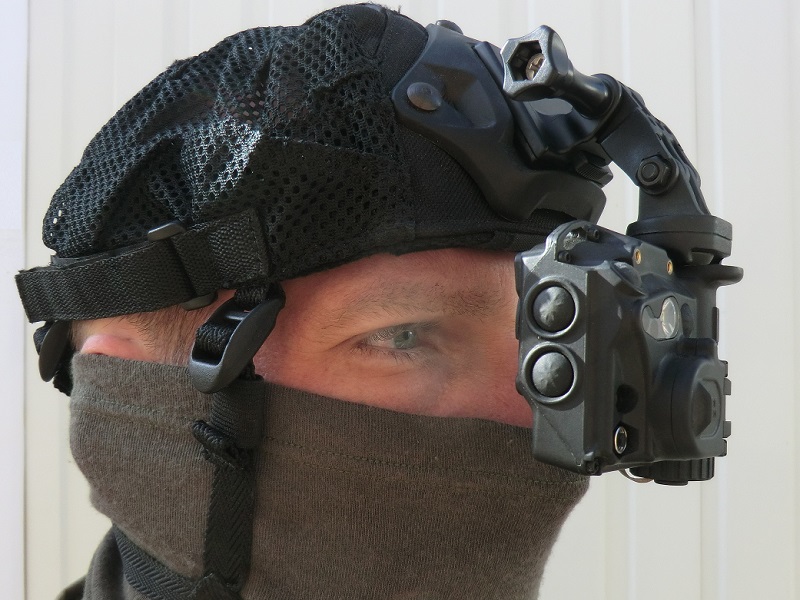 Die Funktion der unterschiedlichen Lampen wurde zwar getestet, aber während der Jagd nicht genutzt. Für eine möglichen Optimierung der TILO-3Z+ kann meiner Meinung nach auf sämtliche LED´s verzichtet werden. Ebenfalls die Entfernungsschätzfunktion ist eine nette Funktion aber ebenfalls für die Jagd vernachlässigbar.
Die Funktion der unterschiedlichen Lampen wurde zwar getestet, aber während der Jagd nicht genutzt. Für eine möglichen Optimierung der TILO-3Z+ kann meiner Meinung nach auf sämtliche LED´s verzichtet werden. Ebenfalls die Entfernungsschätzfunktion ist eine nette Funktion aber ebenfalls für die Jagd vernachlässigbar.
Militärischer Test
Der militärische Test wurde ebenfalls zweigeteilt. Die TILO-3Z+ wurde als Beobachtungsgerät am Helm sowie als Vorsatzgerät an einem Sturmgewehr mit Zielfernrohr 1,5-6 x 24 verwendet. Die Adaption am Helm gestaltete sich mit den dazu gelieferten Adaptern problemlos. Als Testobjekt diente ein Ops-Core Fast Ballistic Helm. Die Montage an das Zielfernrohr wurde mit einem 30mm Adapter von der Firma ACTinBlack realisiert. Die Anpassungen an der TILO-3Z+ waren problemlos möglich.
Verwendung am Helm
 Als Standard wird im Einsatz ein Nachtsehgerät in der Funktionsweise Restlichtverstärker genutzt um in Verbindung mit einem Rotpunktvisier Ziele bei Nacht bekämpfen zu können. In diesem Fall wurde die GPNVG18 von L3 Insight Technology sowie die Argus Brille von der Firma Theon Sensors verwendet.
Als Standard wird im Einsatz ein Nachtsehgerät in der Funktionsweise Restlichtverstärker genutzt um in Verbindung mit einem Rotpunktvisier Ziele bei Nacht bekämpfen zu können. In diesem Fall wurde die GPNVG18 von L3 Insight Technology sowie die Argus Brille von der Firma Theon Sensors verwendet.
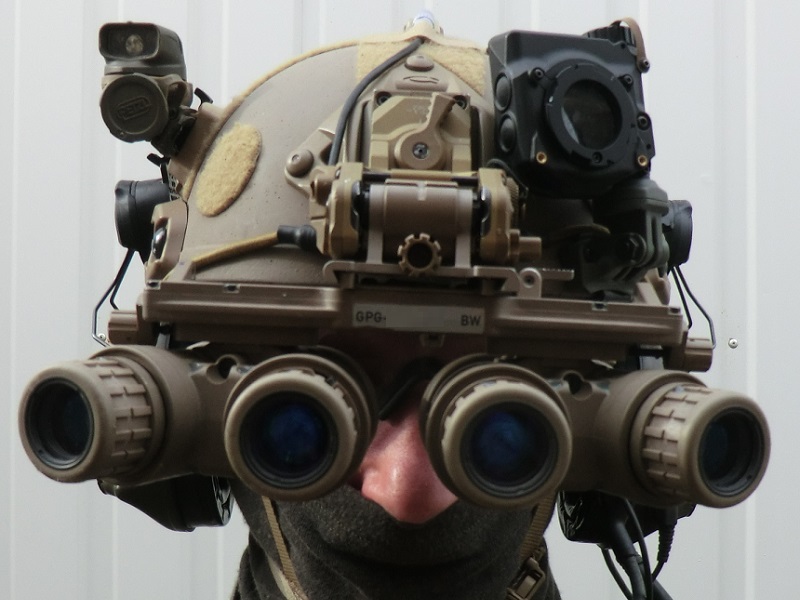 Die TILO-3Z+ wurde zusätzlich an den Helm angebracht, um ergänzend zum Restlichtverstärker eine schnelle Verfügbarkeit von Wärmebildtechnologie zu gewährleisten. Aufgrund der kleinen Bauweise ließ sich das mit der TILO sehr gut realisieren. Da in der GPNVG Röhren mit grünem Phosphor verbaut sind, wurde die TILO-3Z+ mit dem Thermalfilter CG = Cold Green verwendet. So kann sichergestellt werden, dass beide Augen einer grünen Darstellung ausgesetzt sind.
Die TILO-3Z+ wurde zusätzlich an den Helm angebracht, um ergänzend zum Restlichtverstärker eine schnelle Verfügbarkeit von Wärmebildtechnologie zu gewährleisten. Aufgrund der kleinen Bauweise ließ sich das mit der TILO sehr gut realisieren. Da in der GPNVG Röhren mit grünem Phosphor verbaut sind, wurde die TILO-3Z+ mit dem Thermalfilter CG = Cold Green verwendet. So kann sichergestellt werden, dass beide Augen einer grünen Darstellung ausgesetzt sind.
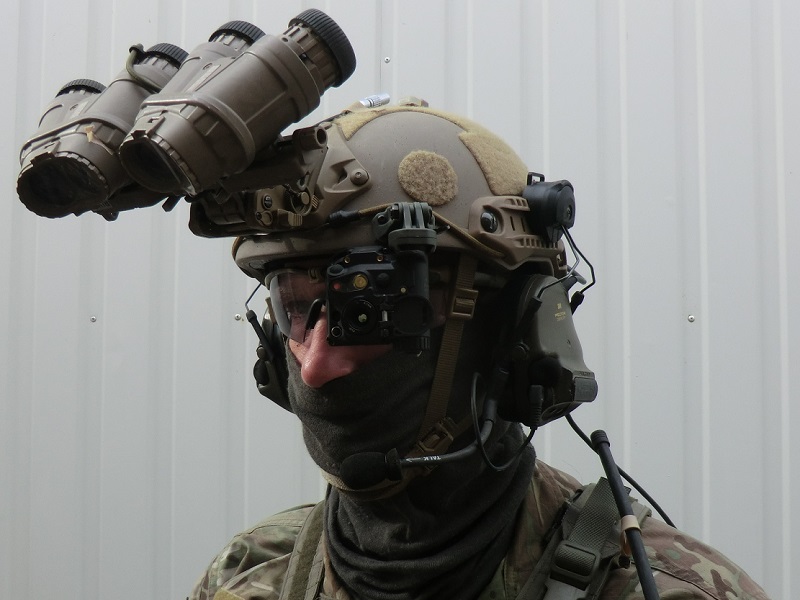 Die TILO-3Z+ konnte gut vor das Auge positioniert werden. Eine Kompatibilität mit dem Restlichtverstärker war gegeben. Die beiden Geräte ergänzend sich hervorragen und aufgrund der unterschiedlichen Funktionsweisen der Nachtsichtgeräte wurde die Aufklärfähigkeit des Anwenders erhöht. Die TILO-3Z+ wurde so wie Abgebildet fast täglich genutzt.
Die TILO-3Z+ konnte gut vor das Auge positioniert werden. Eine Kompatibilität mit dem Restlichtverstärker war gegeben. Die beiden Geräte ergänzend sich hervorragen und aufgrund der unterschiedlichen Funktionsweisen der Nachtsichtgeräte wurde die Aufklärfähigkeit des Anwenders erhöht. Die TILO-3Z+ wurde so wie Abgebildet fast täglich genutzt.
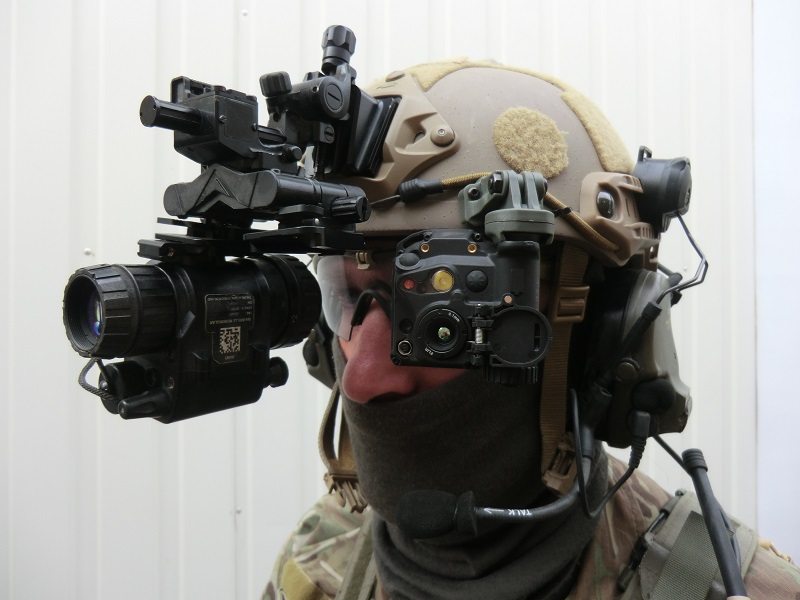 Im weiteren Verlauf wurde die TILO mit einer Theon Sensors Argus Restlicht Brille verwendet. Die Restlichtbrille wurde als Monokular installiert, damit der Anwender auf dem linken Auge die TILO und auf dem rechten Auge (Schießauge) den Restlichtverstärker nutzt. Durch die Kollimation wurde eine saubere Bilddarstellung sichergestellt. Diese Konfiguration ermöglichte dem Anwender gleichzeitig Wärmebild und Restlichtverstärkung zu nutzen. Dies stellt einen unschätzbaren, taktischen Vorteil dar.
Im weiteren Verlauf wurde die TILO mit einer Theon Sensors Argus Restlicht Brille verwendet. Die Restlichtbrille wurde als Monokular installiert, damit der Anwender auf dem linken Auge die TILO und auf dem rechten Auge (Schießauge) den Restlichtverstärker nutzt. Durch die Kollimation wurde eine saubere Bilddarstellung sichergestellt. Diese Konfiguration ermöglichte dem Anwender gleichzeitig Wärmebild und Restlichtverstärkung zu nutzen. Dies stellt einen unschätzbaren, taktischen Vorteil dar.
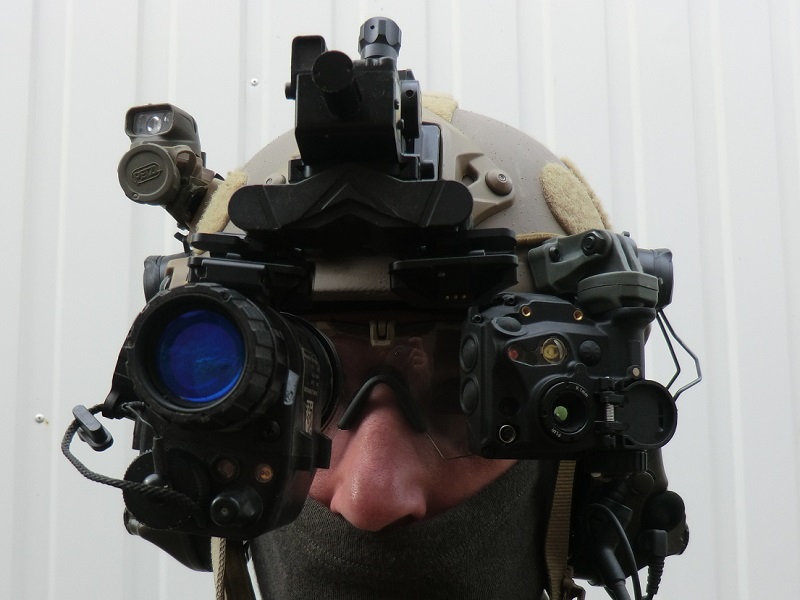 Mit dem GPNVG wurde ebenfalls die Funktion als Kopflampe nicht genutzt, da die LED´s an der Vorderseite angebracht sind. Im Hochgeklappten Zustand ist der Gebrauch der Lampenfunktion nicht zweckmäßig. Beim heruntergeklappten Zustand wäre die Funktion möglich, jedoch würde dann eine Augenseite durch die TILO-3Z+ verdeckt und somit nicht optimal verwendet. Im kombinierten Ansatz wäre der Einsatz der IR LED denkbar und zweckmäßig jedoch aufgrund der Leuchtkraft in Verbindung einer ITT Gen. 3 Röhre nur in absolut dunklen Räumen nutzbar (siehe IR LED Test).
Mit dem GPNVG wurde ebenfalls die Funktion als Kopflampe nicht genutzt, da die LED´s an der Vorderseite angebracht sind. Im Hochgeklappten Zustand ist der Gebrauch der Lampenfunktion nicht zweckmäßig. Beim heruntergeklappten Zustand wäre die Funktion möglich, jedoch würde dann eine Augenseite durch die TILO-3Z+ verdeckt und somit nicht optimal verwendet. Im kombinierten Ansatz wäre der Einsatz der IR LED denkbar und zweckmäßig jedoch aufgrund der Leuchtkraft in Verbindung einer ITT Gen. 3 Röhre nur in absolut dunklen Räumen nutzbar (siehe IR LED Test).
Die Jungs von Andres Industries haben eine Vermutung, warum die IR-LED der TILO durch US GEN3 Röhren so schlecht gesehen wurde: es liegt am Wellenlängenbereich der Röhre. Die US Röhren decken den langwelligen IR Bereich (>900 nm) nicht so gut ab, wie die europäischen Röhren. Die IR-LED der TILO hat eine Wellenlänge von 940 nm und liegt knapp außerhalb der maximalen Wahrnehmung der US GEN3 Röhre.
Verwendung als Vorsatzgerät
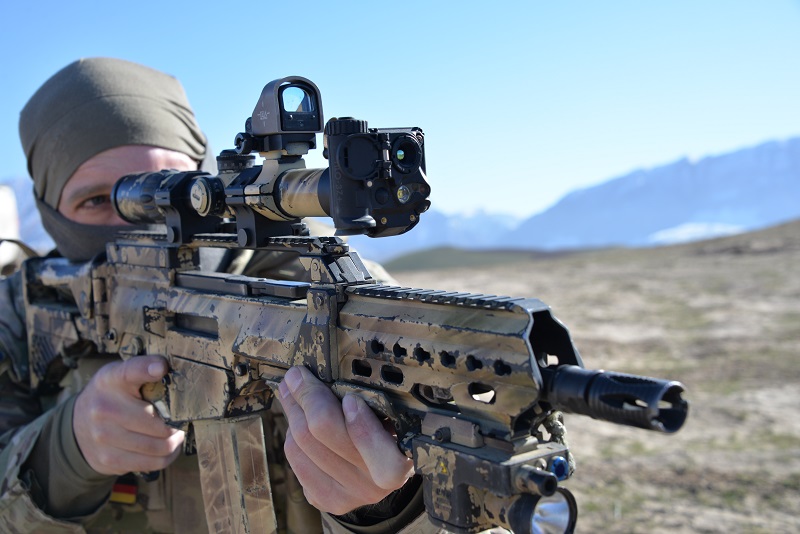 Im weiteren Verlauf wurde die TILO-3Z+ als Vorsatzgerät an einem Zielfernrohr Schmidt und Bender 1,5-6 x24 auf ein Sturmgewehr montiert um auch hier die Vorteile des Wärmebildes zu nutzen. Die Montage gestaltete sich in Verbindung mit dem 30mm Kameraadapter von der Firma ACTinBlack als problemlos. Das Anschießen und die Kollimation wurden entsprechend der Anleitung durchgeführt und funktionierte ohne Probleme.
Im weiteren Verlauf wurde die TILO-3Z+ als Vorsatzgerät an einem Zielfernrohr Schmidt und Bender 1,5-6 x24 auf ein Sturmgewehr montiert um auch hier die Vorteile des Wärmebildes zu nutzen. Die Montage gestaltete sich in Verbindung mit dem 30mm Kameraadapter von der Firma ACTinBlack als problemlos. Das Anschießen und die Kollimation wurden entsprechend der Anleitung durchgeführt und funktionierte ohne Probleme.
Während dem Test wurde unter anderem auf Stahlziele mit einer Größe von 30cm x 40cm gewirkt. Als Entfernungen wurden von 100m bis 350m gewählt. Die Stahlziele erwärmten sich durch die Sonneneinstrahlung und konnten auf 50m sehr gut identifiziert werden. Die TILO-3Z+ stößt in Verbindung mit dem Zielfernrohr auf längeren Distanzen (ab 150m) an ihre Grenzen. Eine eindeutige Identifizierung der Ziele war nicht mehr gegeben.
 Vermutlich sind die Sensorauflösung von 320 x 256 Pixel 60Hz in Verbindung mit dem kleinem Objektiv und dem vorgesetzten Zielfernrohr die leistungseinbußenden Faktoren. Eine Sensorauflösung von 640 x 512 Pixel mit einer 3-fach Vorsatzlinse ist in dieser Verwendungsvariante die optimale Konfiguration, um den taktischen Vorteil des Wärmebildes auf Distanzen über 150m eindeutig ausspielen zu können.
Vermutlich sind die Sensorauflösung von 320 x 256 Pixel 60Hz in Verbindung mit dem kleinem Objektiv und dem vorgesetzten Zielfernrohr die leistungseinbußenden Faktoren. Eine Sensorauflösung von 640 x 512 Pixel mit einer 3-fach Vorsatzlinse ist in dieser Verwendungsvariante die optimale Konfiguration, um den taktischen Vorteil des Wärmebildes auf Distanzen über 150m eindeutig ausspielen zu können.
Eine weitere Überlegung wäre es die TILO-3 als ein eigenständiges „Stand Alone“ Wärmebildzielgerät zu konfigurieren und zu montieren. Ein justierbares Absehen müsste natürlich in das Menü implementiert werden. Eine Montageschnittschnelle an die jeweilige Waffenplattform in Form von Picatinny bietet sich an.
Fazit militärischer Test
 Abschließend ist zu sagen, dass die TILO-3Z+ adaptiert am Helm ein nicht zu missender Helfer im taktischen Szenario darstellt. Aufgrund des geringen Gewichts stört die TILO-3Z+ am Helm nicht und unterschützt mit der Wärmebilderkennung erheblich den Anwender auf dem Gefechtsfeld. Montiert vor ein Zielfernrohr kann die TILO-3Z+ ihre Stärken nur bedingt ausspielen, ist aber mit Einschränkungen dafür geeignet.
Abschließend ist zu sagen, dass die TILO-3Z+ adaptiert am Helm ein nicht zu missender Helfer im taktischen Szenario darstellt. Aufgrund des geringen Gewichts stört die TILO-3Z+ am Helm nicht und unterschützt mit der Wärmebilderkennung erheblich den Anwender auf dem Gefechtsfeld. Montiert vor ein Zielfernrohr kann die TILO-3Z+ ihre Stärken nur bedingt ausspielen, ist aber mit Einschränkungen dafür geeignet.
IR LED Test
Der IR LED Test wurde mit drei unterschiedlichen Restlichtverstärkerröhren durchgeführt. Ziel war es die Leuchtkraft der IR LED der TILO-3Z+ in Verbindung mit GEN 3 Röhren darzustellen.
Folgende Röhren wurden verwendet:
- GPNVG von L3 Insight Technology GEN 3 L3 Röhre grüner Phosphor
- FGE von L3 Insight Technology GEN 3 Röhre weißer Phosphor
- Argus Panoptes von Theon Sensors GEN 3 ITT Röhre grüner Phosphor
Im ersten Anlauf wurde die Helligkeit im urbanen Umfeld mit Restlicht getestet. Alle drei Röhren wurden zugeschaltet und die Leuchtkraft der LED hatte keinen sichtbaren Effekt. Eine Bildauswertung war nicht zielführend.
Im zweiten Anlauf wurde ein Wohncontainer komplett verdunkelt. Eine Papier Mannscheibe wurde in einer Entfernung von ca. 12m aufgehängt. Es wurde jeweils ein Bild ohne Beleuchtung, ein Bild in der niedrigsten Beleuchtungsstufe der IR LED der TILO-3Z+ sowie ein Bild in der höchsten Beleuchtungsstufe der IR LED der TILO-3Z+ gemacht:
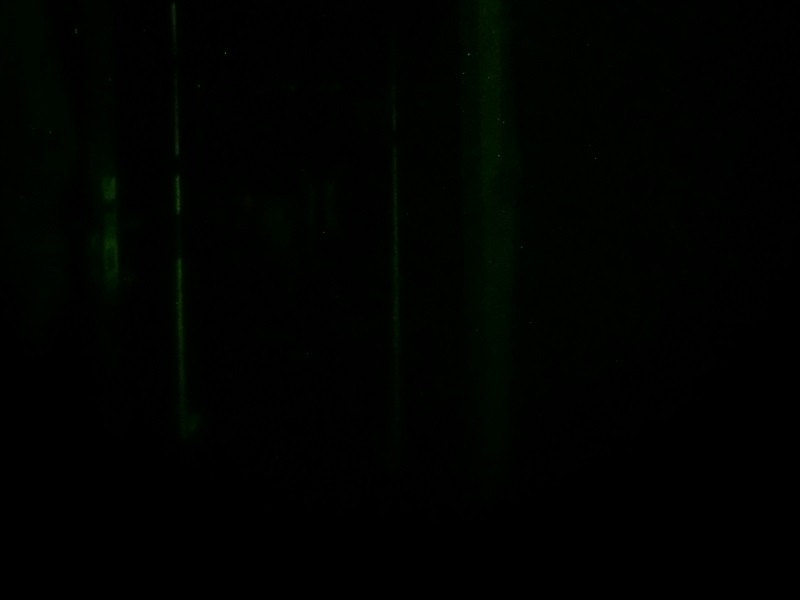 GPNVG von L3 Insight Technology GEN3 L3 Röhre grüner Phosphor, ohne TILO IR-LED
GPNVG von L3 Insight Technology GEN3 L3 Röhre grüner Phosphor, ohne TILO IR-LED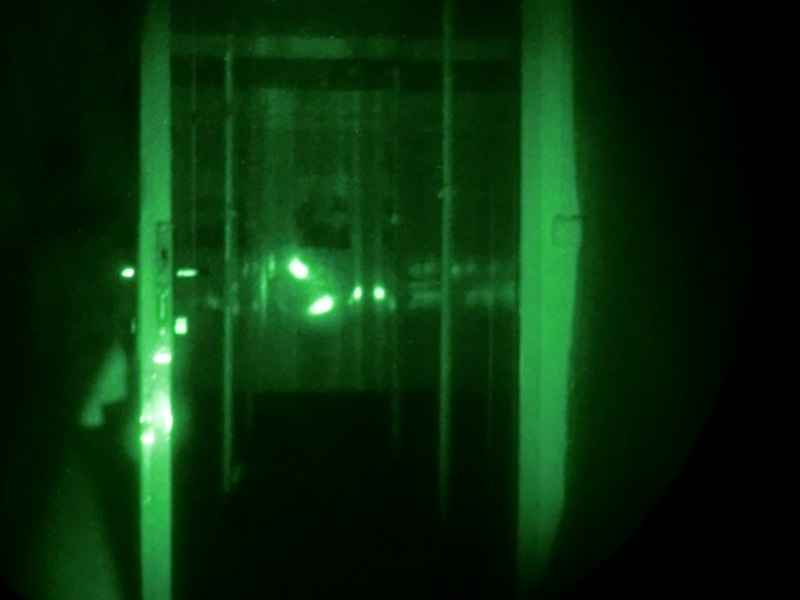 GPNVG von L3 Insight Technology GEN3 L3 Röhre grüner Phosphor, TILO IR-LED in niedrigster Stufe
GPNVG von L3 Insight Technology GEN3 L3 Röhre grüner Phosphor, TILO IR-LED in niedrigster Stufe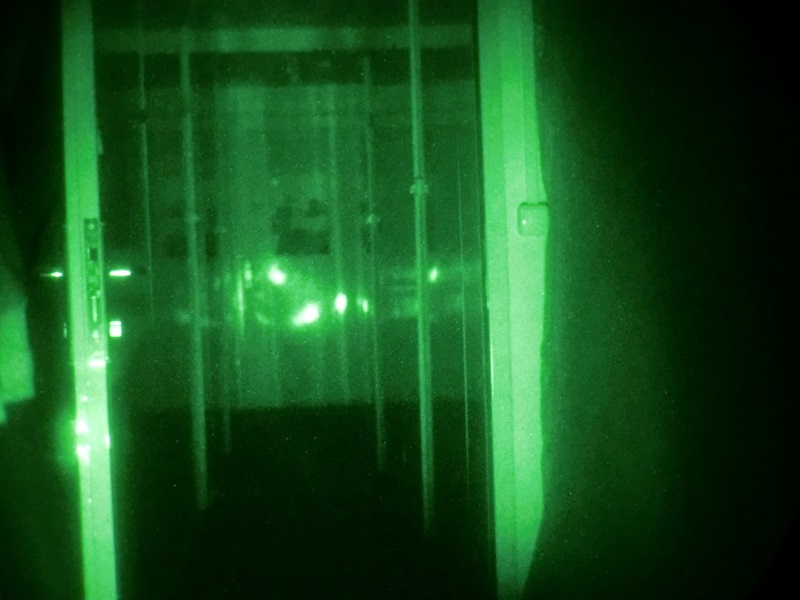 GPNVG von L3 Insight Technology GEN3 L3 Röhre grüner Phosphor, TILO IR-LED in höchster Stufe
GPNVG von L3 Insight Technology GEN3 L3 Röhre grüner Phosphor, TILO IR-LED in höchster Stufe
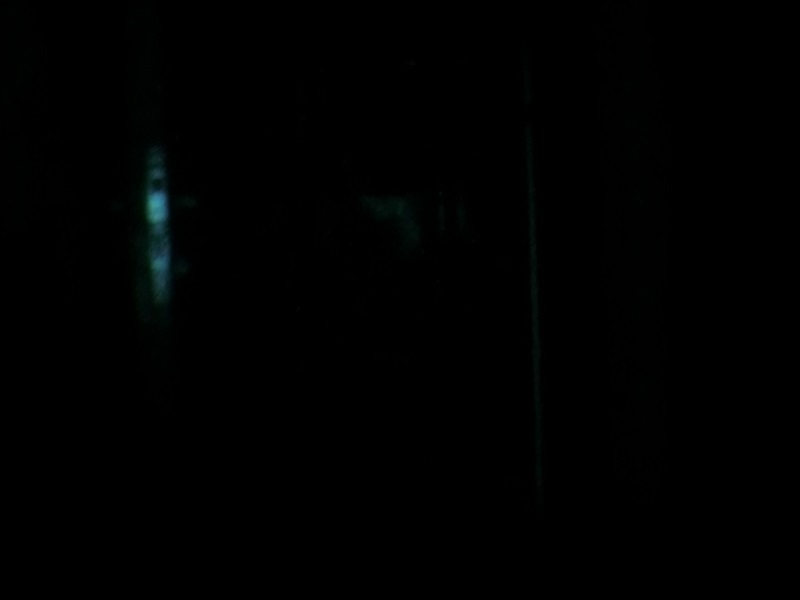 FGE von L3 Insight Technology GEN3 Röhre weißer Phosphor, ohne TILO IR-LED
FGE von L3 Insight Technology GEN3 Röhre weißer Phosphor, ohne TILO IR-LED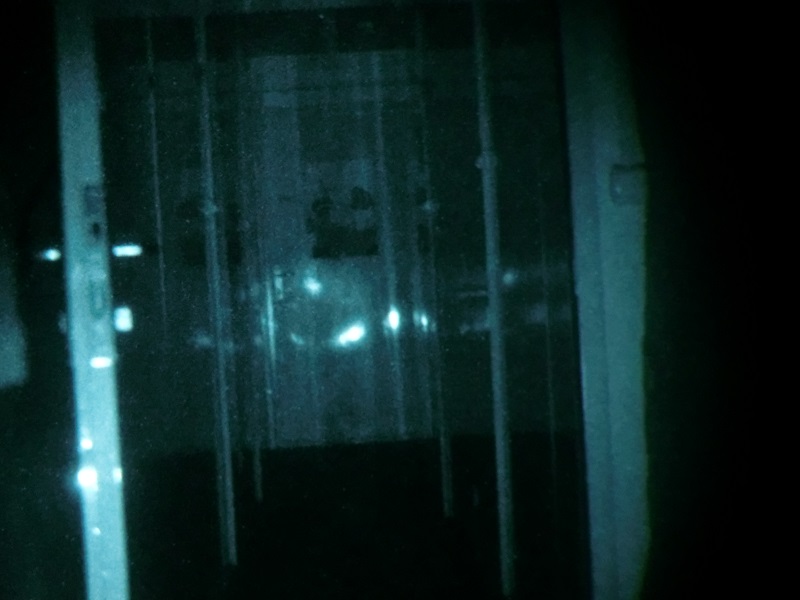 FGE von L3 Insight Technology GEN3 Röhre weißer Phosphor, TILO IR-LED in niedrigster Stufe
FGE von L3 Insight Technology GEN3 Röhre weißer Phosphor, TILO IR-LED in niedrigster Stufe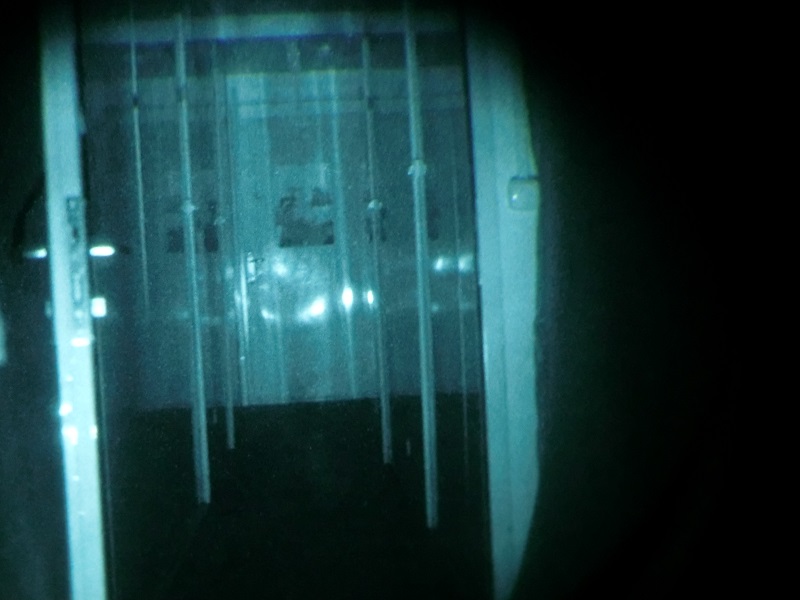 FGE von L3 Insight Technology GEN3 Röhre weißer Phosphor, TILO IR-LED in höchster Stufe
FGE von L3 Insight Technology GEN3 Röhre weißer Phosphor, TILO IR-LED in höchster Stufe
 Argus Panoptes von Theon Sensors GEN3 ITT Röhre grüner Phosphorohne, TILO IR-LED
Argus Panoptes von Theon Sensors GEN3 ITT Röhre grüner Phosphorohne, TILO IR-LED
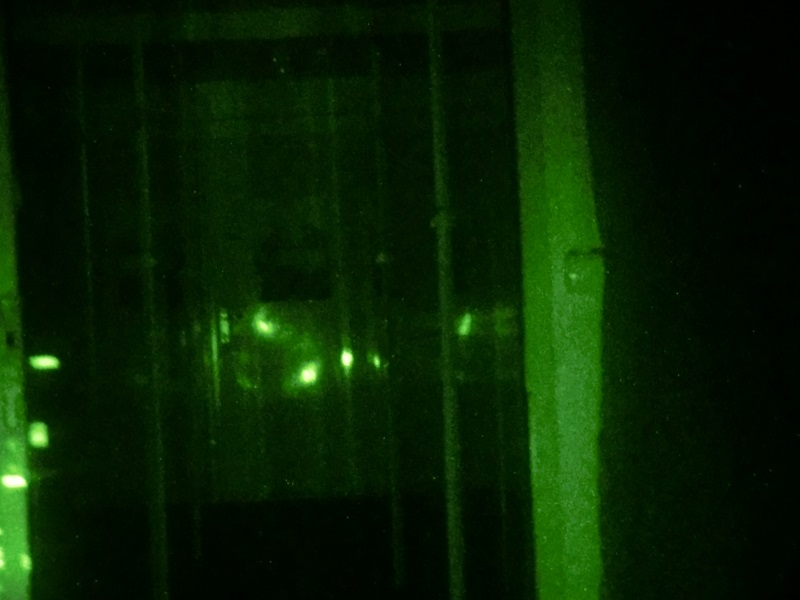 Argus Panoptes von Theon Sensors GEN3 ITT Röhre grüner Phosphorohne, TILO IR-LED in niedrigster Stufe
Argus Panoptes von Theon Sensors GEN3 ITT Röhre grüner Phosphorohne, TILO IR-LED in niedrigster Stufe
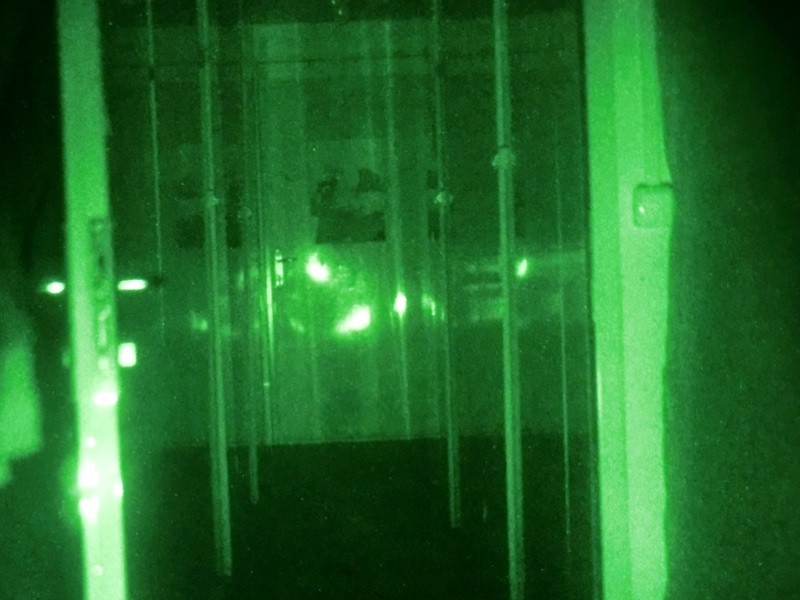 Argus Panoptes von Theon Sensors GEN3 ITT Röhre grüner Phosphorohne, TILO IR-LED in höchster Stufe
Argus Panoptes von Theon Sensors GEN3 ITT Röhre grüner Phosphorohne, TILO IR-LED in höchster Stufe
Die IR LED der TILO-3Z+ ist durch GEN3 Röhren bekannter US Herstellern zu erkennen. Das Papier Target ist problemlos zu erkennen und die Waffendarstellung auf dem Target konnte klar identifiziert werden. Vorausgesetzt sind die absolute Dunkelheit der vorhandenen Umgebung, sowie eine relativ kurze Distanz zum angestrahlten Medium. Vermutlich wäre die Reichweite der IR LED der TILO-3Z+ in Verbindung mit den oben genannten Restlichtverstärkerbrillen auf bis zu 20m-30m zu schätzen. Es muss angemerkt werden, dass die hier abgebildeten Situationen in der Realität mit dem Auge viel besser zu erkennen sind als auf den Fotos.
Wie schon gesagt, liegt es wahrscheinlich am Wellenlängenbereich der US Gen3 Röhre, dass das IR-Licht so wenig aufgehellt hat.
Fazit
Insgesamt ist die TILO-3Z+ eine rundum gelungene Wärmebildkamera, welche ihre Stärken deutlich als ergänzendes Wärmebildnachtsichtgerät ausspielt. Auch in der Jagd ist die TILO-3Z+ ein nützlicher Helfer im Revier. Es war eine Freude die TILO-3Z+ führen und testen zu dürfen. An dieser Stelle noch einmal vielen Dank an die Andres Industries AG. HIER geht es zur SPARTANAT TILO Review.
ACTinBlack im Internet: actinblack.lu
ANDRES INDUSTRIES im Internet: www.andres-industries-shop.de
Alle TILO-Challenge Berichte:
TILO-Challenge (1): Wärmebild am Spielfeld
TILO-Challenge (2): Die TILO bei polizeilichen Spezialkräften
TILO-Challenge (3): Die TILO beim Militär
TILO-Challenge (4): Die TILO bei den spezialisierten Kräften
SPARTANAT ist das Online-Magazin für Military News, Tactical Life, Gear & Reviews.
Schickt uns eure News: [email protected]
Werbung
Hol Dir den wöchentlichen SPARTANAT-Newsletter.
Dein Bonus: das gratis E-Book von SPARTANAT.


